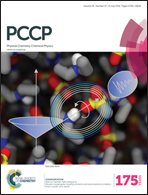Structure and bonding in crystalline cesium uranyl tetrachloride under pressure†
Abstract
A thorough investigation of pressure effects on the structural properties of crystalline cesium uranyl chloride was performed by means of first-principles calculations within the density functional theory framework. Total energies, equilibrium geometries and vibrational frequencies were computed at selected pressures up to 50 GPa. Zero pressure results present good agreement with available experimental and theoretical data. Our calculated equation of state parameters reveal that Cs2UO2Cl4 is a high compressible material, similar to other ionic compounds with cesium cations, and displays a structural anisotropic behavior guided by the uranyl moiety. An unexpected variation of the U–O bond length, dUO, is detected as pressure is applied. It leads to a dUO-stretching frequency relationship that cannot be described by the traditional Badger's rule. Interestingly enough, it can be explained in terms of a change in the main factor controlling dUO. At low pressure, the charge transferred to the uranyl cation induces an increase of the bond length and a red shift of the stretching frequencies, whereas it is the mechanical effect of the applied pressure above 10 GPa that is the dominant factor that leads to a shortening of dUO and a blue shift of the stretching frequencies.


 Please wait while we load your content...
Please wait while we load your content...